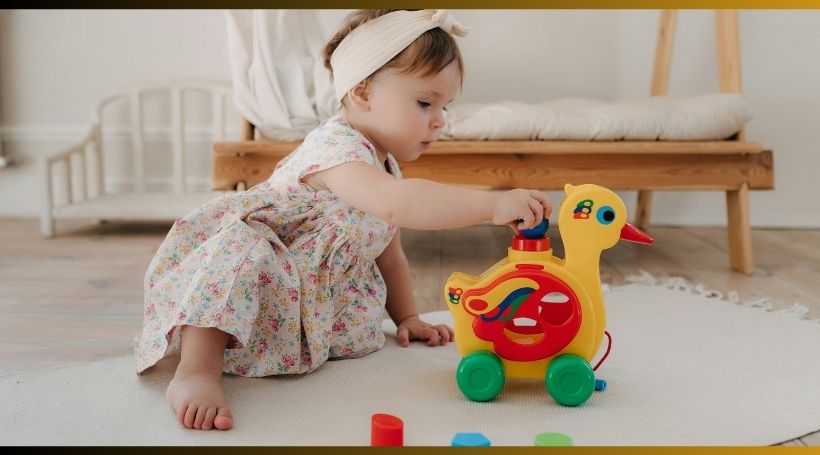Last Updated on October 19, 2025
Choosing the right toys for children is much more than picking colorful or popular items off the shelf; it’s about selecting age-appropriate playthings that foster growth and development across key areas—physical, cognitive, emotional, and social. The right toys support skills such as hand-eye coordination, problem-solving, creativity, and communication, helping children reach milestones while having fun.
In this guide, explore expert tips for buying toys that promote healthy development according to age groups, from newborn sensory stimulation to active play for toddlers and imaginative toys for preschoolers. You’ll also learn why some classic items combine comfort and developmental benefits perfectly.
Why Age-Appropriateness Matters
Toys that are too advanced may frustrate a child and fail to engage, while those that are too simple can become boring quickly. Age-appropriate toys are designed to match a child’s motor skills, attention span, and cognitive abilities, providing a “just right” challenge that spurs progress.
They also minimize safety risks: small parts for younger kids can be choking hazards, while heavy, complex toys may overwhelm toddlers. Clear age recommendations on packaging help guide choices, but parents should also consider their child’s unique interests and pace of development.
Newborn to 6 Months: Stimulating Senses Safely
At this stage, babies explore mostly through sight, sound, and touch. Choose toys that encourage sensory engagement:
- Soft, high-contrast fabrics, such as black-and-white patterns, stimulate the vision.
- Rattles and crinkly toys promote auditory senses.
- Tummy time mats with different textures help build neck and upper body strength.
Always opt for items free of harmful chemicals and firmly attached parts.
6 to 12 Months: Encouraging Movement and Exploration
As infants grow, they begin to reach, grasp, and eventually crawl or stand. Toys that invite physical interaction aid motor development:
- Stacking blocks and nesting cups teach spatial skills and hand-eye coordination.
- Push-and-pull toys stimulate walking and balance.
- Interactive sound books introduce cause and effect through light taps or squeezes.
- Teething rings also soothe sore gums while providing safe chewing options.
Look for toys with easy-to-hold shapes and non-toxic finishes that are dishwasher-safe for hygiene.
1 to 2 Years: Supporting Language and Problem-Solving
Toddlers gain vocabulary rapidly and begin understanding simple concepts. Toys to encourage communication and cognition include:
- Shape sorters and simple puzzles build reasoning skills.
- Dolls and stuffed animals encourage nurturing and role play.
- Musical instruments like tambourines and drums develop auditory processing.
- Ride-on toys and balls support gross motor skills and coordination.
Toys with clear instructions or open-ended play options inspire creativity and language use.
2 to 3 Years: Expanding Creativity and Social Skills
Preschoolers benefit from toys that promote imaginative play and social interaction:
- Dress-up costumes and play kitchens let children mimic real-life roles.
- Building sets with interlocking pieces challenges fine motor control and patience.
- Storybooks and interactive tablets designed for toddlers encourage early literacy.
- Group games encourage sharing and turn-taking.
Look for durable materials safe for energetic play and easy to clean.
3 to 5 Years: Encouraging Learning and Independence
As kids prepare for school age, toys that improve concentration, problem-solving, and independence are ideal:
- Advanced puzzles and board games sharpen strategic thinking.
- Craft kits and drawing supplies cultivate fine motor skills and self-expression.
- Science kits or nature exploration tools foster curiosity about the world.
- Sports equipment, such as mini basketball hoops, supports physical fitness.
Check that toys reflect your child’s interests and provide achievable challenges to keep them motivated.
Additional Tips for Smart Toy Buying
- Safety First: Always verify toys meet relevant safety standards and avoid small parts for children under 3.
- Check Reviews: Parent and expert feedback help ensure the quality and developmental value of the product.
- Opt for Multi-Use Toys: Items like blocks or dolls can serve many functions, growing with your child.
- Limit Screen Time: Balance tech toys with hands-on, active play.
- Rotate Toys: Keep play interesting by switching toys out every few weeks to spark engagement.
Why Classic Stuffed Animals Still Matter
A timeless choice, stuffed animals offer emotional comfort and can be lifelong companions for children. A giraffe stuffed animal from Crane Baby, for example, is designed with soft, safe fabrics and friendly features that are perfect for fostering emotional security in infants and toddlers.
Beyond cuddles, plush toys encourage pretend play, language development through storytelling, and the development of social skills, such as empathy. They are an effortless way to integrate play and comfort into your child’s daily routine.
Buying toys that promote developmental milestones while matching your child’s age and interests sets the stage for happier, more engaged learning and play. From sensory-rich toys for newborns to imaginative sets for preschoolers, thoughtful selection encourages physical, cognitive, and emotional growth while protecting safety.
Incorporate versatile, durable, and age-appropriate toys into your child’s world with new, activity-driven options. This careful curation helps nurture confident and creative children, ready for all the adventures ahead.
Read More – Why Early Intervention Matters in Speech Development: A Parent’s Guide

